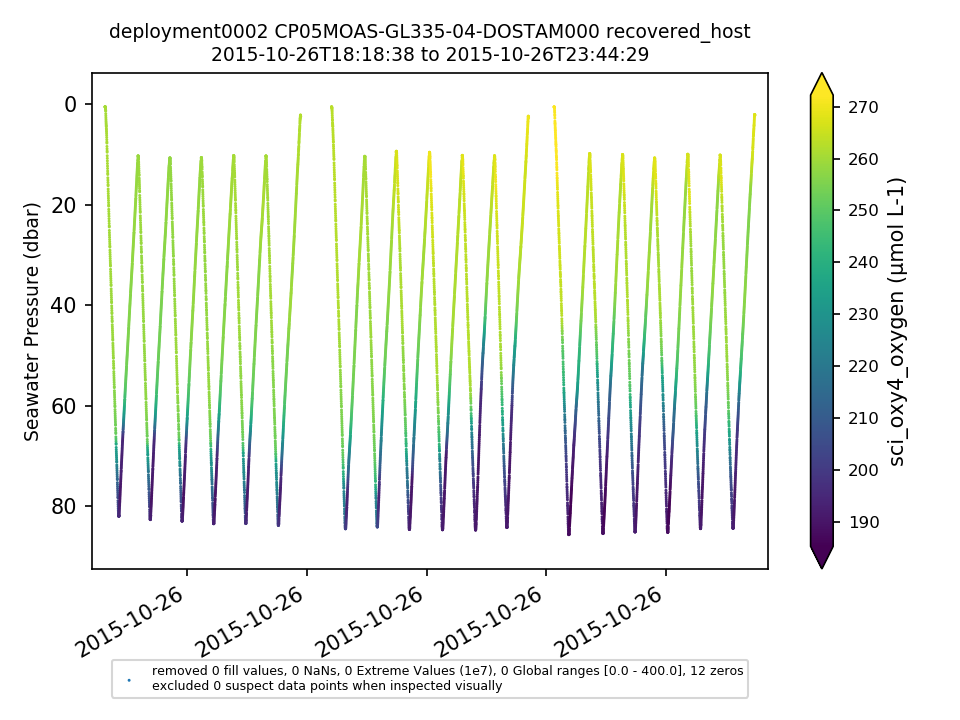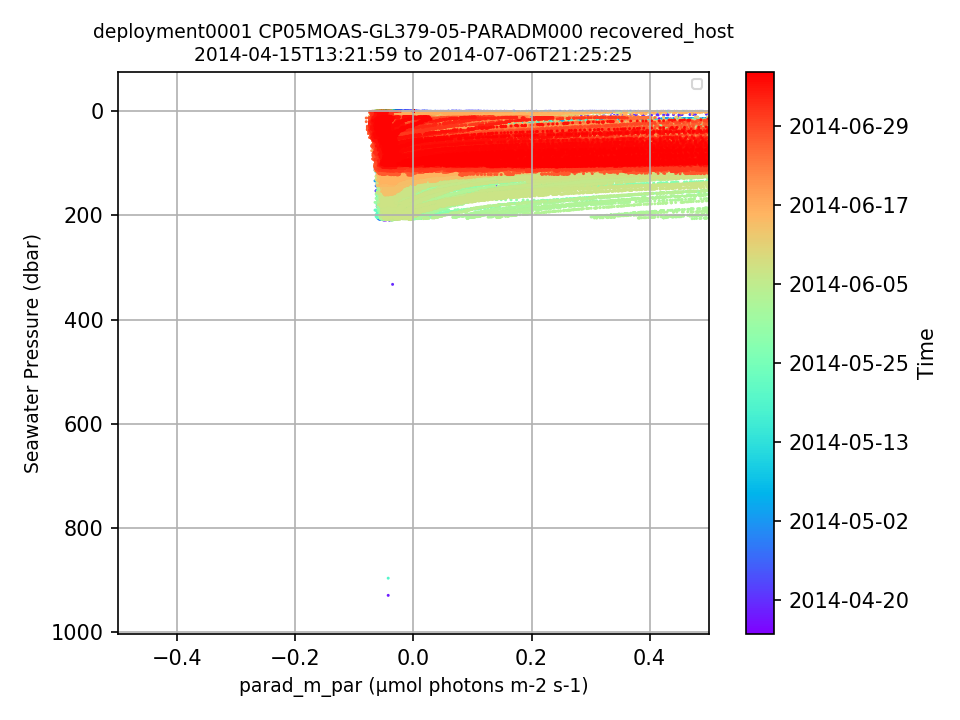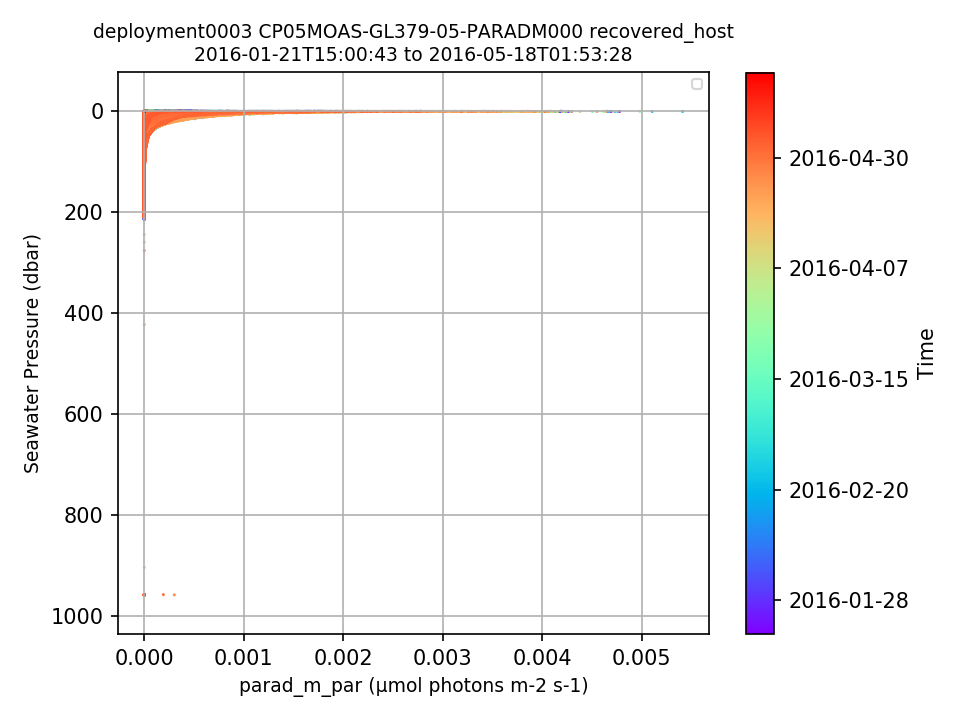Photosynthetically Available Radiation
- Reference Designator
- CP05MOAS-GL379-05-PARADM000
- Review Status
- Review Complete
- Note
- Depth
- 0 to 1,000m
- Class
- PARAD (Photosynthetically Available Radiation)
- Make / Model
- Biospherical Instruments / QSP-2155
Dataset Reviews Last processed: 4/15/19, 7:12 PM
| Dep. | Preferred Method | Stream | DD | FD | SG | EG | Gaps | GD | TS | Rate (s) | Pressure Comp. | Time Order | Valid Data | Missing Data | Data Comp. | Missing Coords. | Review |
|---|---|---|---|---|---|---|---|---|---|---|---|---|---|---|---|---|---|
| 1 | recovered_host | 88 | 83 | 0 | 4 | 0 | 0 | 2,237,560 | 1 | 1000 / 209 | Complete | ||||||
| 2 | recovered_host | 55 | 48 | 0 | 6 | 0 | 0 | 630,441 | 1 | 1000 / 214 | Complete | ||||||
| 3 | recovered_host | 119 | 119 | 0 | 0 | 0 | 0 | 1,590,347 | 1 | 1000 / 276 | Complete | ||||||
| 4 | telemetered | 1 | 1 | 0 | 0 | 0 | 0 | 198 | 60 | 1000 / 210 | 1 | 1 | Complete |
Test Notes
- no other streams for comparison
Data Coverage
| Deployment: | 1 | 2 | 3 | 4 |
|---|---|---|---|---|
| 100% | ||||
| 94% | 87% | 100% |
Deployment Map

System Annotations Show
| Metadata | Start Date | End Date | Comment |
|---|---|---|---|
|
CP05MOAS-GL379 |
1/16/17, 7:46 AM | 1/16/17, 6:59 PM |
Glider leaked and was recovered within 12 hours. No recovered data are expected.
Id: 357
By: leila
|
|
CP05MOAS-GL379 |
1/16/17, 7:46 AM | 1/16/17, 6:59 PM |
Glider recovered same day for leak.
Id: 643
By: leila
|
|
CP05MOAS-GL379 |
11/18/19, 3:59 PM | 11/18/19, 11:35 PM |
Deployment 8: Glider experienced early battery failure and science was disabled on 2019-11-18. No telemetered or recovered science data expected after this date.
Id: 1822
By: cdobson
|
Review Notes
| Metadata | Start Date | End Date | Comment |
|---|---|---|---|
|
CP05MOAS |
Bad altimeter pings are apparent in many deployments of the coastal gliders. A few example plots are attached - m_water_depth plotted as semi-transparent bathymetry. By Lori Garzio, on 5/10/19 |
||
|
CP05MOAS |
Glider optodes typically exhibit a sensor lag of 20-25 seconds. Example attached of several segments with consecutive down and up casts for CP05MOAS-GL335-04-DOSTAM000 on 10/26/2015 showing a typical measurement time lag. Profiles should be analyzed for individual time lags and data should be adjusted. OOI doesn't necessarily need to make the adjustment but users should be aware of the issue. By Lori Garzio, on 5/15/19 |
||
|
CP05MOAS-GL379-05-PARADM000 |
sci_bsipar_par is the unscaled L0 PAR data product. The global ranges for this parameter are the same as for the scaled L1 PAR data product [0.0, 2500.0]. The global range for sci_bsipar_par should be reviewed. By Lori Garzio, on 5/10/19 |
||
|
CP05MOAS-GL379-05-PARADM000 Deployment: 1 |
|||
|
CP05MOAS-GL379-05-PARADM000 Deployment: 2 |
|||
|
CP05MOAS-GL379-05-PARADM000 Deployment: 3 |
|||
|
CP05MOAS-GL379-05-PARADM000 Deployment: 3 |
71% of the param_m_par data are outside of global ranges [0.0, 2500.0]. By Lori Garzio, on 5/10/19 |
||
|
CP05MOAS-GL379 Deployment: 4 |
Annotation ID 643 is a duplicate of 357 By Lori Garzio, on 5/7/19 |



